My Background
My first real PDA was a Palm Professional, in 1997, after a succession of those little calculator
organizer devices that look like they fell out of a Christmas cracker. In 2000 I changed to a Palm Vx, and I’ve also used the
Compaq iPaq and Palm
IIIc. PDAs are just one of the technical gadgets I use extensively. This review was originally written after about two weeks of intensive m505 use, in response to the many questions about the m505. It has been updated a couple of times since.
Physical
The Vx was a classic design. The m505 looks better, I think. It is also noticeably heavier. When I checked, I was surprised to find that the difference is only 20 grams; 139 for the m505 versus 119 for the Vx. I’d hate to use an even heavier PDA! The iPaq is 164, without sleeve, and the IIIc is 193. It is questionable whether PDAs that heavy are truly
pocketable.
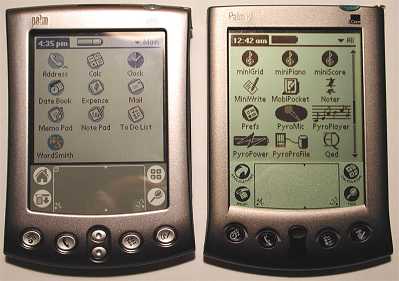
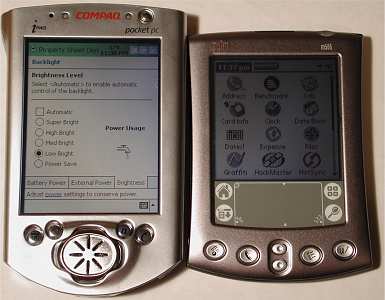
Physically, the m505 is slightly shorter than the Vx, but I don’t notice it, just the weight. Having said that, the weight is still fine, much less than any other colour PDA and the m505 is eminently pocketable.
Upgrading and compatibility
Upgrading to the m505 from the Vx was simple. I just connected the cradle, enabled USB
hotsync in place of serial, and hotsynced. Five minutes later all my applications and data were set up on the m505 and the Vx was officially retired. Of course, there was some additional configuration to do such as add new apps to my shortcuts, but it was all very easy.
For some reason Palm haven’t seen fit to make styli and cases backwards-compatible. The m505 stylus is identical to the Vx series, except for the topmost section, the bit that actually holds the stylus in the unit. That is 3mm shorter on the m505. So, if you unscrew that section and get a shorter m505 version, you can reuse your old stylus.
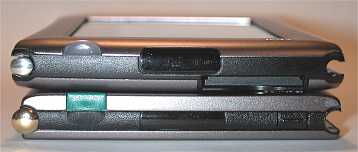
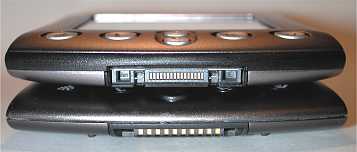
I do recall reading that some aftermarket Vx styli do work, but as I never used a special stylus so it doesn’t worry me. I was annoyed about having to get a new case (case, note, not ‘house’), but when I did so I found the Slim Leather m505 case has four little SD card slots so it was worth it!
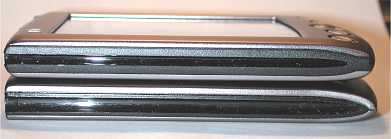
The screen
The m505’s screen has been much maligned, and with good reason. It’s nothing like as good as the iPaq, or as bright as the IIIc. However, if you keep the backlight on, it’s quite useable, probably about the same as low brightness on the iPaq. Because of the constant backlighting required, Palm have even released a utility that remembers the backlight state so the backlight is on when the device is turned on, or off, depending on the state it was in when you powered the device off.
In direct light the backlight is not required, and the higher the light, the better the display. Some PDAs such as the IIIc are all but unusable in direct light conditions. Unfortunately, the m505 is at its worst in medium light, such as that sometimes found indoors. Having said that, I think it’s fine with the backlight. This is in my view (sic) the worst problem with the m505.
There is no contrast control either, unlike the IIIc. Both the iPaq and IIIc have bright, vibrant colours. The m505 looks more pastel in comparison, but it does have a richer colour depth. Photos look better on the m505 than the IIIc because the IIIc has only 256 colours. Applications look better on the IIIc because of its brightness. Not sure about the iPaq, probably closer to the IIIc than the m505.
I think Palm made a mistake with the m505 marketing. They should have kept the backlight on as a default, similar to the way people use iPaqs, CLIEs and all other devices with similar screen technology. I am sure few people would have complained had they done this.
The bottom line is that the screen is quite usable at all times with the backlight on.
Compared to the Vx the screen is a definitive improvement in terms of refresh rates. If you have ever played a game or on the Vx where images move across the screen, for example Pong or Billards, then you’ll be familiar with the “shadow” effect, similar to early LCD laptop computers. On the m505 the display is very sharp and there is no similar effect.
Performance
Speed. The Vx was a lot quicker than my old Palm Professional. The m505 takes speed to another dimension. It is very, very fast. Flicking from datebook to address to todo and so shows some of the quickest responses I’ve ever seen on a computer, certainly a PDA. Far quicker than Vx, and way faster than the IIIc and also the iPaq. As another example, loading AvantGo on the m505 is probably 2-3 seconds quicker on the m505, and the IIIc is not even close to the Vx. Resetting the world map on CityZen is 2 seconds quicker on the m505 compared to the Vx. The m505 uses a 33Mhz CPU as opposed to the Vx’s 20Mhz unit, and the percentage speed increase is probably the same as the difference in CPU clock speeds.
The m505 also hotsyncs by USB, which is an improvement over serial due to the significantly quicker speed.
The Expansion Slot
The m505 takes MMC (MultiMedia) or SD (Secure Digital) Cards. These cards are tiny, about the size of a postage stamp. They are an industry standard and used frequently in digital cameras and digital camcorders. I think they are going to take over from the larger Compact Flash cards. MMC and SD are identical, except that the SD cards have better security features.
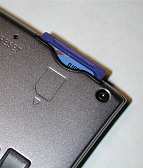
I spent SG$130 on a 64Mb MMC card. Flashmemory.com.au
has a 64Mb SD card for AU$285. On the card I have 60 or so photos and a 12Mb video, plus a few books and applications. Still 43Mb free! The photos are good quality. I love the fact I have 72Mb of storage on this tiny device! When you install apps you choose where they can go, either to the main memory or the card, so the 8Mb limit is effectively broken. However, not all apps work with the expansion card yet.
You can copy applications to and from the handheld and card, and rename or reformat the card. Card data can also be beamed. What I like about the expansion slot is that it doesn’t increase the size of the device, and it would be feasible to carry another four cards around in the case, as well as one in the machine, without significantly increasing the size or weight. Size is important to me.
It is interesting to compare the m505 with its 8Mb memory and small CPU against the iPaq with 32Mb and a 206Mhz CPU. I’ve not done any performance or capacity tests, but my money would be on the m505. I have also run out of space on the iPaq pretty quickly after loading up videos and images.
Note that to remove the expansion card you must press it down further into the slot, and it will pop up. Do not try and remove it by pulling it out.
I have a USB SD card reader, and this means I can remove my MMC/SD card, insert it in the reader and it appears as a
removable drive in Windows Explorer. From there it is easy to copy files and applications to and from the card.
Operating System
Lots of little improvements all over the place, such as a Graffiti-area shortcut to a clock, better IR integration,
time zone and DST support, more Preferences, backlit Graffiti area and so on. No major revolutions, as usual, but all the little changes add up. The Notepad feature is handy, as it allows you to free-write any text on the screen, and set an alarm with it. The image is hotsynced back to the desktop where it can be copied to another application, for example Paintbrush. Pity the process doesn’t work in reverse.
You can now use the onscreen keyboard and Graffiti area at the same time. Security is improved with more options for locking things up. Alarm handling is centralized. If you miss an alarm when you start using the device a tiny asterisk appears in the top-left corner. Click it and it’ll show you the alarm you missed.
Even a couple of weeks after converting from the Vx, I’m finding new OS features. I just noticed that when you do a Graffiti upstroke ( / ), for example before copying, you now have a row of little icons you can click instead of having to do a
Graffiti “c” for copy or “x” for cut, for example. Only the icons relevant to the operation are displayed, for example if you select text you get Cut and Copy, without text selected it may be options like Beam, Delete and Lock.
Bundled Applications
Documents to Go is fantastic. It allows you to read and edit Excel and Word documents, and read PowerPoint and PDF files. It also checks for changes and
synchronizes the two copies. DTG 3.0 will come with an m505, and DTG 4.0 has been released on 6/8/01. This will be a free upgrade if you buy an m505 now, or you bought yours within 30 days prior to DTG’s release. DTG 4 adds the PowerPoint viewer, PDF viewer and lots of Excel editing features, as described below.
The Word editor allows you to change text and formatting, such as colour, font size, bold, italics and so on. There are paragraph alignment tags too. It displays tables and table-of-contents well. It is also the viewer for Adobe PDF files. These are reasonably well displayed although the table of contents on one file was garbled.
The Excel editor can change cell alignment, colour, and there are many functions like ABS, ACOS, AVERAGE, SUM, COUNTA, date functions, database (DSUM etc), HLOOKUP, IF, ISNA, text replacement like RIGHT, TRIM etc. There are also all the usual number formatting options like percentage, commas as thousand separators and so on. It’s a pretty powerful little tool.
The PowerPoint viewer views the entire slide, and allows a zoom-in which can be moved over the slide so the detail can be read.
All DTG documents can be stored on the expansion card, which is definitely a bonus, and all include search facilities, including an option to link to the global search.
You also get the Mobile Internet Kit with your m505, which has a free SMS sender and email (POP3) client. Haven’t used these yet because of an installation problem. I already have a SMS utility.
The Palm Reader is a doc (e-book) reader in the same format as iSilo, CspotRun and so on. The reader takes slightly longer to access card-based books, but it is still very
useable, and very quick once you’re in.
All the applications I had on my Vx work without any problem, including Hacks. I have not heard about any issues with backwards compatibility.
Photos and Video
Photosuite is the application for viewing videos and photos. It’s not particularly good. Tealpoint’s TealMovie (not included with the m505) is a far superior video application because it supports sound (!) and has a realistic frame rate. Finally, video clips on the Palm are a reality! Not great, but workable. However, I would say the PocketPC does video better, because of the size of the screen and quality of the sound
With Photosuite, accessing the first photo on the card takes 30-40 seconds, but once you’re there, it’s really quick and the remainder load instantly. That is a limitation of the Photosuite software, not the system as such.
The quality of photos is good. Colour depth is excellent, and resolution is good. Photos can be panned around quickly if zoomed in. You can certainly show off holiday snaps or anything else to good effect.
Other software
Palmscape is an excellent web browser. Supports colour, frames, and shortly, SSL. Shareware, and highly recommended. DrawIt is a very powerful drawing program, which is also well worth the price – free. Neither are included with m505, but both are colour and work very well with it.
Other hardware features
The vibrate function is useless. You’ll only notice it if the m505 is balanced on a sensitive part of your anatomy (I am guessing here, having not tried it). What is useful is the power button, which flashes to alert you of reminders.
Still no sound, but the beeps are much louder and there are more options to choose from. TealMovie does a creditable job of music and speech through the speaker. As someone who owns more CD stacker space than he does audio CDs, you can imagine that’s not something I’m overly worried about. For those of you that want MP3 capability, use a PocketPC or the new Sony CLIE.
The rocker button is recessed, which means less accidental powerons. However, I still managed to turn it on using the Notepad button by accident, so this problem is not completely solved.
The cradle is not very well designed, with no stylus holder for example. It has been the target of complaints too, but while I can’t say it is an improvement I don’t think it is a particular issue.
Battery life
I estimate the m505 could last 2-4 days under my usage pattern, which consists of probably 1-1.5 hours of various work, plus 4-5 infrared hotsyncs of 3-4 minutes each, per day, downloading 300 or so pages from AvantGo, and using the SD card. That’s not as good as the Vx, but it’s close. If I was on holiday it would be better because I’d hotsync less and also probably use it less. Most of the above is also backlit work, aside from the hotsyncs. The battery has changed from the Vx, so presumably it is better technology.
I have once managed to go from a full battery to a “please charge” message in a single day. That was with about 4 hours of usage with the backlight on, reading ebooks, playing games and a few IR hotysncs.
Summary
The m505 is a significant improvement over the Vx in many ways. I used my old Vx after a few m505 days and immediately noticed it was much slower. Whenever I use a friend’s Vx, it immediately seems so dated and slow.
The bundled m505 apps are useful, I love being able to store photographs and all the little touches like the clock and the power button are good. The power of the expansion slot cannot be underestimated. There is no more concern about lacking space to store photos, videos, Word files or anything else. I am eagerly awaiting extra SD cards, especially the Bluetooth version so I can connect to my forthcoming Bluetooth mobile phone (Nokia 6310). The GPS card will also be on my shopping list.
I couldn’t go back to a Vx now, and am very pleased with my m505. As time goes on I have become more and more pleased with the m505.
Should you buy one? Do you need one?
I would look at the entire PDA market before buying. There are very few poor PDAs on the market, and there is no “best” model any more than there is a “best” car, computer or area to live. The models that are considered the best-of-breed are the m505, the Sony CLIE, Toshiba Genie, Compaq iPaq and Handera 330 in particular.
There are new PDAs coming out every couple of months, but as ever, there is NEVER a good time to buy technology. Start waiting and you’ll never stop.
If you haven’t really explored the potential of your Vx with lots of apps, Internet connectivity and so on, and just use the four basic PDA apps, you probably don’t need an m505 or to replace it with anything else. I think this is an upgrade for power users, unless you particularly need a given feature. In fact, I’m recommending the Vx for those unsure about the utility of PDAs as they are now excellent value for money, while stocks last. The real reason to upgrade is the expansion slot. Being able to store all that data is just great. The other reasons like the colour, speed, application tweaks and so on are just extra justifications but you soon find they become indispensable.
Note that Palm OS 4 will be available for the Vx later this year, and some of the software described above can be purchased. However, you won’t be able to leverage all of the 4.0 features, such as the flashing power button and clock shortcut on the
Graffiti area, and it won’t be a free upgrade.
End Note
What became of my Vx? My wife has it. When I upgraded, she had the choice of continuing with her IIIc or using my old Vx. She opted for the Vx because “it’s much lighter, smaller and a lot faster to use”. The lack of colour didn’t bother her because she “doesn’t need it”. The IIIc is now the household spare Palm. I think that’s an interesting anecdote for the PDA market in general.
Price: $449.00 (m505), $299 (Palm Vx)
Pros (in order):
Software is backwards compatible with the rest of the Palm range
Retains the Vx’s tiny size
Tiny expansion slot that doesn’t increase the unit’s size, and uses industry-standard
cards
Speed
65,536 colours, one of the best on the market in this regard
Bundled apps are fantastic, especially Documents To Go
Lots of tiny improvements to the operating system and application
USB hotsync
Flashing power button for silent alarms
Looks
Cons (in order):
Screen should be brighter
Battery life not as good as Vx
Extra 20 grams of weight (note its still the lightest colour unit on the market)
No audio (not that I care, but it’s here anyway)
No stylus holder in the cradle
Stylus and cases not generally backwards-compatible
Wasted vibrate function (in my opinion)
Some of the software improvements will be available for the Vx with Palm OS 4 (but this will not be a free upgrade)
Palm Phone PVG100 (The Small Premium Unlocked Phone) with 32GB Memory and 12MP Camera (Gold)
$199.00 (as of December 1, 2025 20:26 GMT -05:00 - More infoProduct prices and availability are accurate as of the date/time indicated and are subject to change. Any price and availability information displayed on [relevant Amazon Site(s), as applicable] at the time of purchase will apply to the purchase of this product.)Google Palm Phone PVG100 (The Small Premium Unlocked Phone) with 32GB Memory and 12MP Camera (Titanium) (Renewed)
10% OffProduct Information
| Price: | 449.0 |
| Manufacturer: | Palm |



Gadgeteer Comment Policy - Please read before commenting
Post your comments here on the PDAir Sony CLIE TG50 Face Covers Review.
http://www.the-gadgeteer.com/pdair-tg50-face-covers-review.html
Just click the POST REPLY button on this page.
This cover is a great idea. Personally, I think this should be the stock cover. One of the best features of my Treo 300 is that I can quickly check my schedule or a reminder alarm quickly thanks to the clear cover (and the fact that I don’t carry my Treo in any sort of case).
The TG50 has come down in price quite a bit and you can get some great deals on them. I’ve been quite tempted by it, but the feel of the thumbboard is a bit of a letdown to me. It’s workable, but far from comfortable.
Scott
hullo there. i have a palm m505 model but my charger got spoilt. how do i get another exact charger? what make should it be please?
@atuhaire clovis I’m not sure you can find the exact charger, but you can find all kinds of chargers that are compatible with the m505 on eBay.